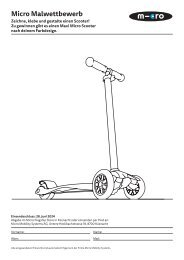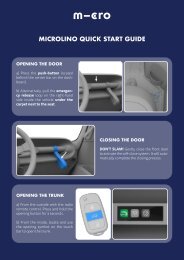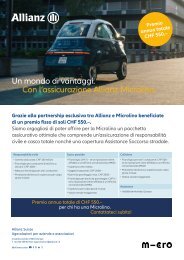Micro Sustainable Impact Report 2023
Pioneering Sustainable Mobility Solutions for a Better Tomorrow
Pioneering Sustainable Mobility Solutions for a Better Tomorrow
Create successful ePaper yourself
Turn your PDF publications into a flip-book with our unique Google optimized e-Paper software.
<strong>Micro</strong><br />
14 <strong>Sustainable</strong> <strong>Impact</strong> <strong>Report</strong><br />
15<br />
We attach great importance to conscious<br />
manufacturing of our products<br />
<strong>Micro</strong><br />
<strong>Sustainable</strong> <strong>Impact</strong> <strong>Report</strong><br />
Ensuring Quality Every Step of the Way: Our On-Site Experts in Asia<br />
Our manufacturing partners also<br />
take measures to reduce water<br />
pollution by keeping rainwater and<br />
wastewater separate on plant premises.<br />
The wastewater is mainly domestic<br />
wastewater, which is pretreated in<br />
a septic tank before being discharged<br />
into the municipal wastewater treatment<br />
plant via the municipal wastewater<br />
network. The wastewater<br />
complies with the Class A emission<br />
standards for pollutants from municipal<br />
wastewater treatment plants<br />
and the emission limits for water pollutants<br />
of the local province.<br />
During the injection molding process,<br />
we do produce a small amount<br />
of non-methane total hydrocarbons<br />
and pollutants. However, we have<br />
implemented measures to reduce<br />
their impact on the environment.<br />
For example, the non-methane total<br />
hydrocarbons are collected by a<br />
gas collection hood with 90% collection<br />
efficiency, and the collected<br />
exhaust gas is treated by an activated<br />
carbon adsorption tower before being<br />
discharged with 90% treatment<br />
efficiency.<br />
Similarly, the hardware workshop produces<br />
welding fumes, but we have implemented<br />
a movable welding fume<br />
purifier to minimize their impact. The<br />
purifier consists of a movable suction<br />
arm and filtration system, which can<br />
collect welding fumes from a close<br />
distance with a collection efficiency<br />
of more than 90%. The filtration system<br />
includes a primary filter, flame<br />
retardant cartridge, and activated<br />
carbon filter, which together can<br />
achieve a filtration efficiency of 99%<br />
or above. In the canteen, we also prioritize<br />
the collection and treatment<br />
of fumes to meet the standards.<br />
Canteen fumes are collected by water<br />
transport fume hoods and discharged<br />
after being treated by fume<br />
purification processors.<br />
Our commitment to sustainability is<br />
at the core of our operations, and our<br />
recycling initiatives within the factories<br />
of our production partners embody<br />
this ethos. In line with our zero<br />
waste policy, all non-utilized injected<br />
parts are meticulously collected<br />
and recycled. These materials are<br />
then reintegrated into the injection<br />
process, ensuring that no resources<br />
are wasted. This circular approach<br />
not only minimizes our environmental<br />
footprint but also enhances the<br />
efficiency of our production cycles.<br />
Finally, we ensure that our waste is<br />
collected and disposed of in a responsible<br />
manner. All domestic waste is<br />
collected and handed over to the<br />
sanitation department for proper<br />
disposal and recycling.<br />
To summarize, we place a high value<br />
on sustainable production practices.<br />
We have implemented measures<br />
such as establishing local supplier relationships,<br />
generating solar power,<br />
reducing water pollution, installing<br />
pollution control facilities, and ensuring<br />
responsible waste disposal.<br />
Workplace safety<br />
Gas collection hood<br />
3. Recycling in to baskets<br />
1. Injection molding waste parts<br />
Local workers<br />
2. Shredding<br />
Introduction<br />
Environment<br />
Social<br />
Governance<br />
<strong>Micro</strong> Partner Stories<br />
At <strong>Micro</strong>, we are dedicated to providing<br />
our customers with the highest<br />
quality products possible. That’s why<br />
we have established a rigorous quality<br />
control program that is overseen<br />
by our experienced quality control<br />
department, located on-site in Asia.<br />
Our strict quality control program<br />
includes testing according to various<br />
regulations such as EN (European<br />
standard), ASTM (American standard)<br />
and GB (Chinese standard), as well as<br />
other country-specific tests. By adhering<br />
to these various regulations and<br />
tests, we are able to achieve a global<br />
level of quality, as each country’s regulations<br />
focus on different aspects of<br />
safety and reliability. This ensures that<br />
every product we manufacture meets<br />
our high standards for durability and<br />
functionality. Our quality control program<br />
has been perfected over many<br />
years and is essential to ensuring a<br />
smooth and efficient production process.<br />
We take great pride in our commitment<br />
to testing our products beyond<br />
the required standards. With<br />
in-house testing facilities and exper-<br />
tise, we’re able to push our products<br />
even further to ensure they meet the<br />
highest level of safety and reliability<br />
for our customers. We don’t just stop<br />
at the required testing; we go above<br />
and beyond to test our products until<br />
they break. This allows us to identify<br />
the weakest part of the product<br />
and make necessary improvements<br />
to ensure it is as durable and safe as<br />
possible. Our ultimate goal is to earn<br />
and keep the trust of our customers.<br />
By going beyond the required standards,<br />
we’re able to provide our<br />
customers with products that are<br />
safe, sustainable and built to last.<br />
Hanging test<br />
Quality control departement<br />
Endurance drum test<br />
Gain insight into<br />
our quality control<br />
procedures<br />
A few impressive quality<br />
testing figures<br />
Kids scooters<br />
Pendulum <strong>Impact</strong> Test<br />
The temperature of the upper deck of<br />
the scooter is conditioned to -15±2C°<br />
and frozen for 4 hours. Afterwards it is<br />
mounted on the scooter and the pendulum<br />
test is performed. The deck must<br />
not show any white marks or cracks.<br />
Handlebar Hanging Test<br />
The scooter is attached to a lateral<br />
suspension device. For 5 minutes 60 kg<br />
weights are hung on the handlebar.<br />
In this case, although there is no prescribed<br />
standard from the Toy standard,<br />
we have replicated the test based<br />
on our adult series. It is important that<br />
the handlebar must not have any visible<br />
deformation, breakage or loss of<br />
function.<br />
Adult scooters<br />
Endurance Fatigue Test<br />
The deck is loaded with a weight of<br />
90 kg and the handles with a weight<br />
of 10 kg each. Afterwards the drum fatigue<br />
test is performed over 750 km.<br />
The scooter must not show any visible<br />
cracks or damage after the test.<br />
Handlebar Hanging Test<br />
Although the EN14619 standard requires<br />
a test in which the scooter is attached<br />
to the wall both forward and<br />
downward and loaded with 50 kg for<br />
5 minutes, we have tested our adult<br />
scooters to withstand a load of 80 kg for<br />
20 minutes while attached to a lateral<br />
suspension device. Even after the test,<br />
the handlebars must not show any<br />
visible deformation, breakage or loss<br />
of function.<br />
Electric scooters<br />
Endurance Riding Test<br />
The e-scooter is driven outdoors with a<br />
user weight of 90 kg and in sport mode<br />
at 25 km/h. After the endurance riding<br />
test over 1’500 km the e-scooter must<br />
not show any visible cracks or damage<br />
to any part of the scooter. The same<br />
test is also performed indoors with<br />
90 kg on the deck and 10 kg on each<br />
handle.<br />
Endurance Drum Test<br />
The e-scooter is loaded with 100 kg on<br />
the deck and 10 kg on the handlebar.<br />
It is then driven at a speed of 25 km/h<br />
over two rotating drums for a distance<br />
of at least 500 km.<br />
Waterproof Test<br />
This test is performed according to<br />
the IPX5 standard by placing the product<br />
under water from top to bottom<br />
and in all directions with a hose. After<br />
15 minutes, it is checked whether all<br />
functions work properly. The test is<br />
performed after the endurance test<br />
and not on a new product to ensure<br />
that waterproofing is also maintained<br />
after wear and tear.<br />
Introduction<br />
Environment<br />
Social<br />
Governance<br />
<strong>Micro</strong> Partner Stories














